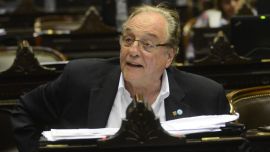Comparisons are odious but the uproar over the weekend slaying of a Ramos Mejía kiosk vendor is in some ways the mirror image of the Santiago Maldonado case in the run-up to the last midterms in 2017. Both tragedies amid far too many (especially in the last 20 months with thousands of especially poignant stories among the 116,000-plus Covid-19 dead) but also electorally charged and media-driven out of all proportion. Beyond the midterm timing in common, the comparison falters because whereas 55 forensic experts all concluded that Maldonado was accidentally drowned while fleeing a clash with security forces, Roberto Sabo’s killer pumped six bullets into him – the very real tip of a huge iceberg.
But the importance given to both cases seems directly related to the proximity of voting. Thus the slaying of Rafael Nahuel would seem to lend itself much better to the indignation of Kirchnerite, leftist and human rights activists – the kid really was Mapuche (unlike Maldonado) and he was killed by a Coast Guard bullet, not accidentally – but this death had the misfortune of coming a month after the 2017 midterms with the Mauricio Macri administration already home and dry so that Nahuel never drew the same interest as Maldonado (still believed to be missing by some) either then or since.
By the same token Sabo’s murder last Sunday (News Vendor’s Day by a cruel irony, one of the few days of the year with no newspapers to sell) has prompted mass outrage more than 18 months after the event over the mass release of convicts from overcrowded prisons as a sanitary precaution round about Easter last year. In fairness, it should be said that there were vociferous protests at the time but they seem almost muted by comparison with last week. In this case not only was the timing of the crime electorally apt but also the place – La Matanza is the ultimate Peronist stronghold within the Peronist stronghold of Buenos Aires Province so finding a chink in that armour was grist to the opposition mill.
Eight weeks into his new job, Security Minister Aníbal Fernández has apparently yet to understand its purpose, which is not to jump on critics of electorally timed school trips like the cartoonist Nik, nor to act as a commentator on crime worldwide instead of the man entrusted with preventing its local version. Nevertheless, the minister’s philosophical (and belated) reflection that “this happens everywhere in the world, in some places worse” was as true as it was callously tactless, as was Buenos Aires Province Governor Axel Kicillof’s comment that “this is a critical problem which goes a very long way back.” Not only does murder most foul occur elsewhere in the world but also in this country – the murder rate in Buenos Aires Province has averaged a couple every day for some years now while Rosario has become a byword for ferocity. Impossible not to read politics into the magnitude ascribed to Sabo’s killing but this is not to denigrate the indignant protests – rather to say that they should be expressed all the time and not just on the eve of an election.
Quite apart from any electoral opportunism, there is also the in-built media proclivity for crime stories. For over a century crime was the bread and butter of the United States press in particular – this did not begin to change until the age of television when John Kennedy pioneered telegenic politics while there were doubts about some crimes as family viewing. The politicisation of crime thus cuts both ways – many media are happy enough to steer away the news to a lower common denominator.
The Maldonado issue raged during the last two months of the Buenos Aires Herald’s existence but my newsroom memories of crimes carrying a political punch long predate it with numerous cases, even if my personal list is not as lengthy as some. Call me naïve or sceptical but I do not buy into all the conspiracy theories and urban legends in circulation. Thus I lean towards the 1995 helicopter death of Carlos Menem Junior being a notorious speed freak buzzing his bodyguards’ car rather than anything more sinister (the bullets appearing in the craft were not there in the inquest immediately after the accident by Bell Helicopters, always anxious to know why when their products go wrong) and I believe that postal tycoon Alfredo Yabrán really did shoot himself in 1998, overwhelmed by the collapse of his business empire after being tagged with the 1997 murder of news photographer José Luis Cabezas, rather than faking his own death.
At the risk of forgetting something from earlier years, my thumbnail list of violent deaths with a news impact would start with the kidnap-murder of Guillermo Ibáñez in mid-1990, mainly remarkable for the importance of his trade union father and Congress Majority Leader Diego Ibáñez, the head of SUPE oil workers. Later that year came by far the more famous case of Catamarca schoolgirl María Soledad Morales, whose brutal murder in 1990 ended half a century’s domination of provincial politics by the Saadi clan following silent marches gathering up to half the population. I was never convinced by the suicide of Carlos Menem’s first Customs director, Brigadier Rodolfo Echegoyen, at the end of that year, nor by the “induced suicide” of businessman Marcelo Cattáneo (mixed up in the IBM-Banco Nación scandal) in 1998 with retired naval officer Horacio Estrada (named in the gun-running charges against Menem) putting a bullet through his head the same year.
That was followed in the next century (2003) by the bizarre death of Lourdes Di Natale, who supposedly fell to her death from her high-rise flat while trying to cut the cable of a neighbour’s noisy television (so ridiculous it might even be true) – the secretary of Menem’s brother-in-law Emir Yoma, she had accused both men of involvement in gun-running to Croatia and Ecuador. But perhaps the greatest similarity with the current Sabo case was the mass reaction to the kidnap-murder of engineering student Axel Blumberg in 2004, which generated a raft of legislation tough on crime. Similar reactions to the 2011 kidnap-murder of 11-year-old Candela Sol Rodríguez, which nevertheless did not prevent a 54 percent landslide for Cristina Kirchner later that year, despite her administration being widely perceived as soft on crime. The 2006 disappearance of human rights trial witness Jorge Julio López (still missing) also had a strong impact. Finally, the biggest mystery of them all, the 2015 death of AMIA prosecutor Alberto Nisman, murder or suicide (there are big holes in both theories to my mind)?



















Comments